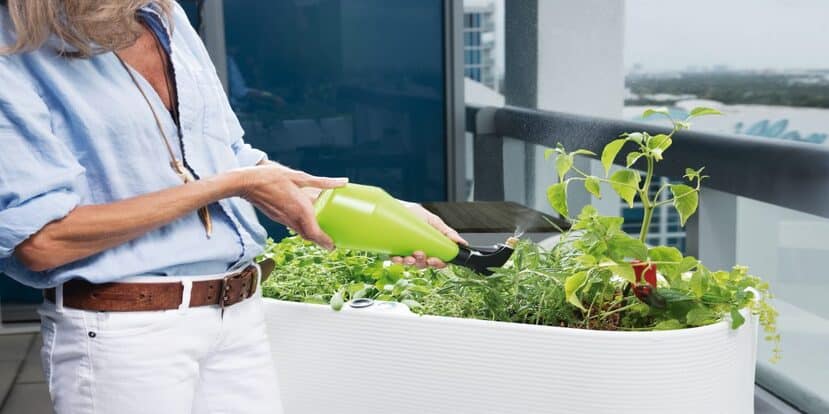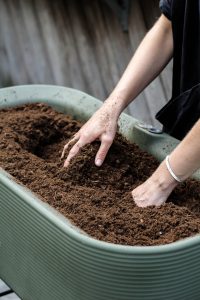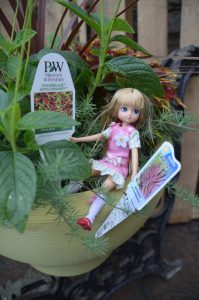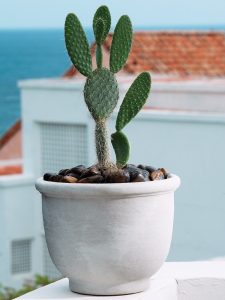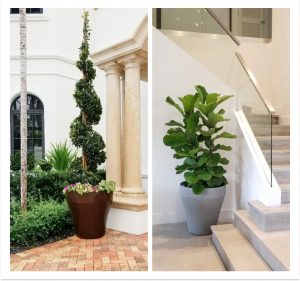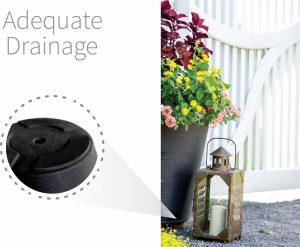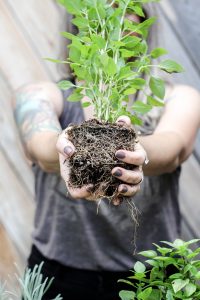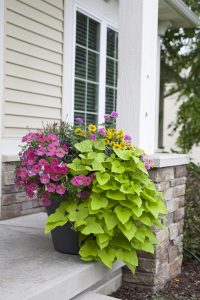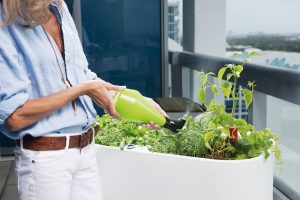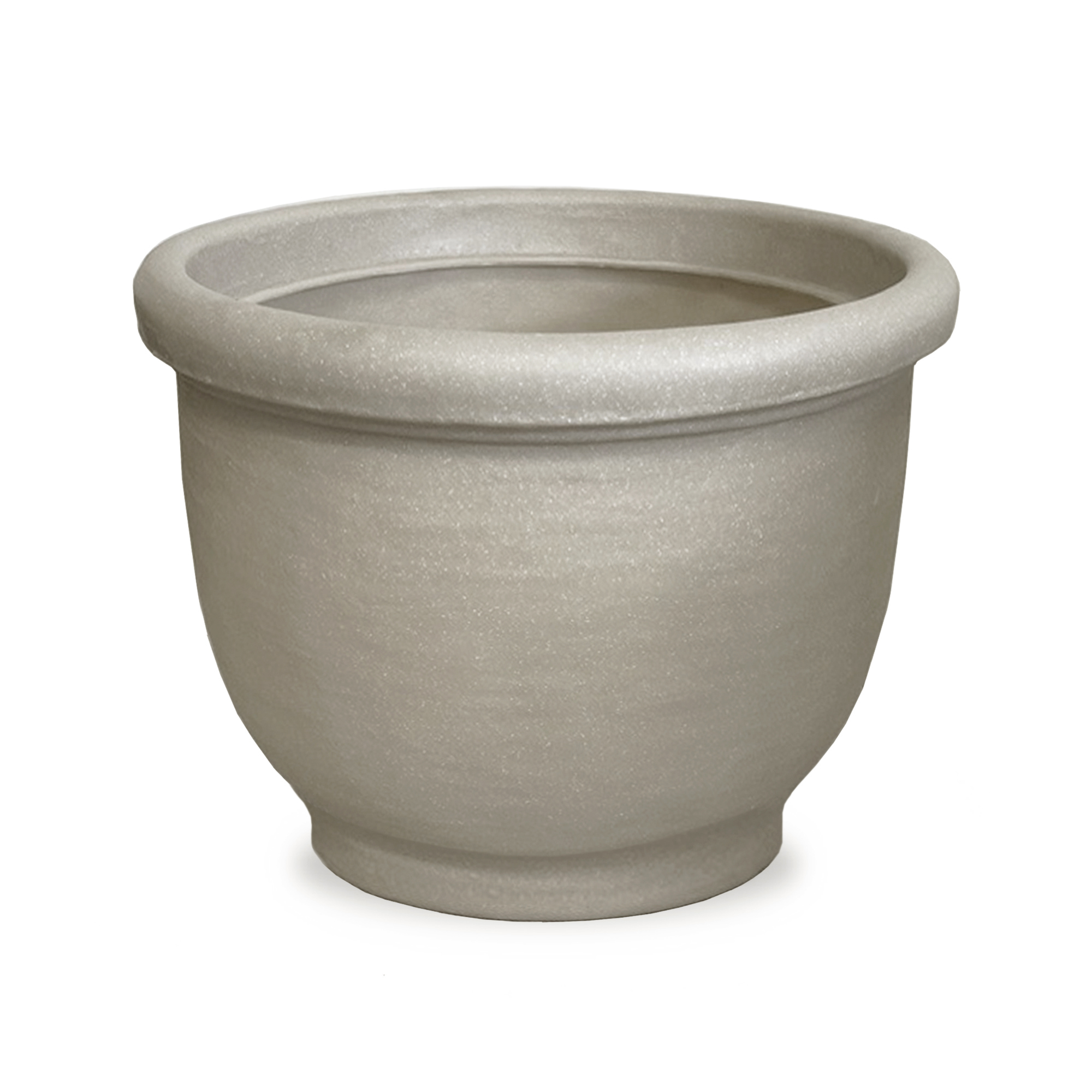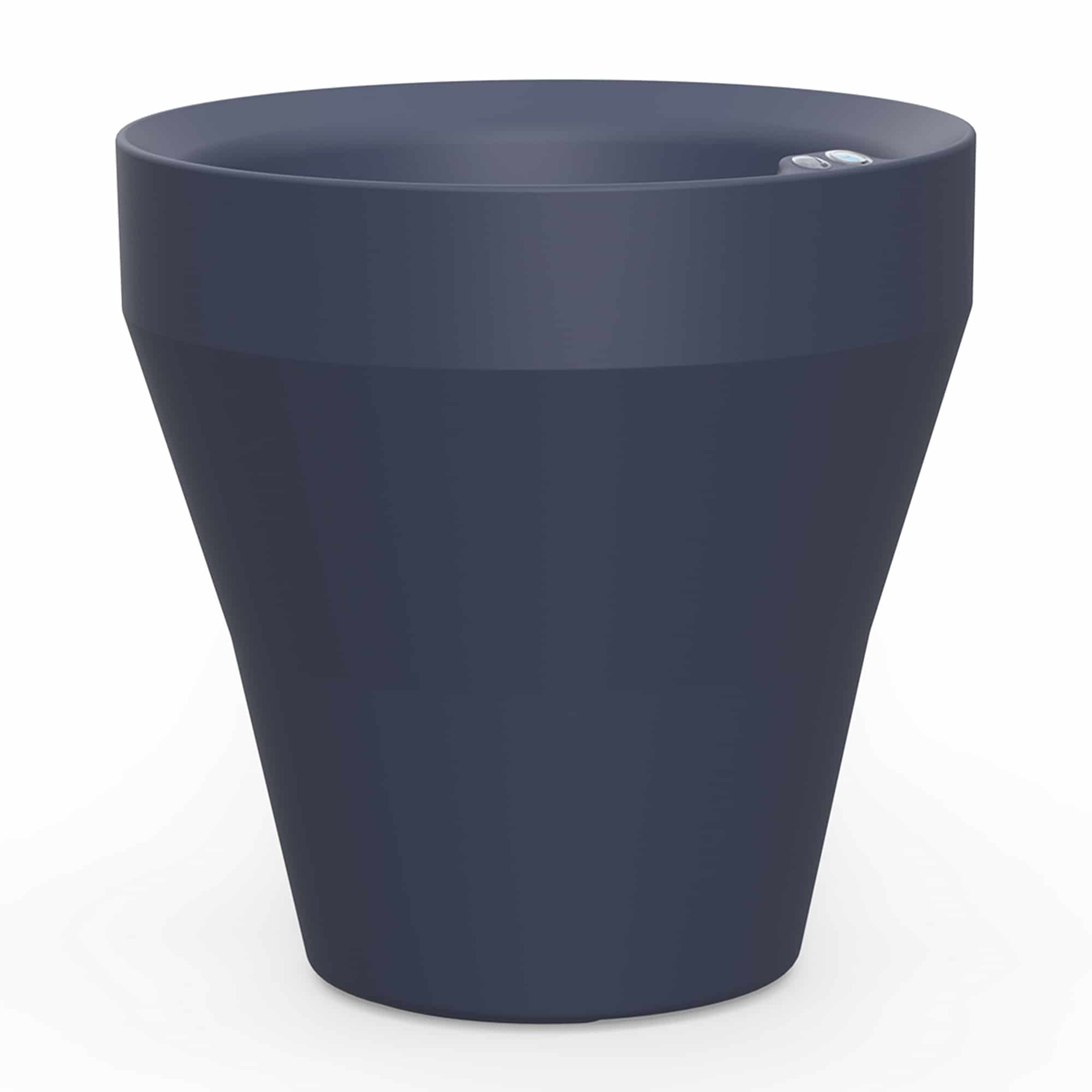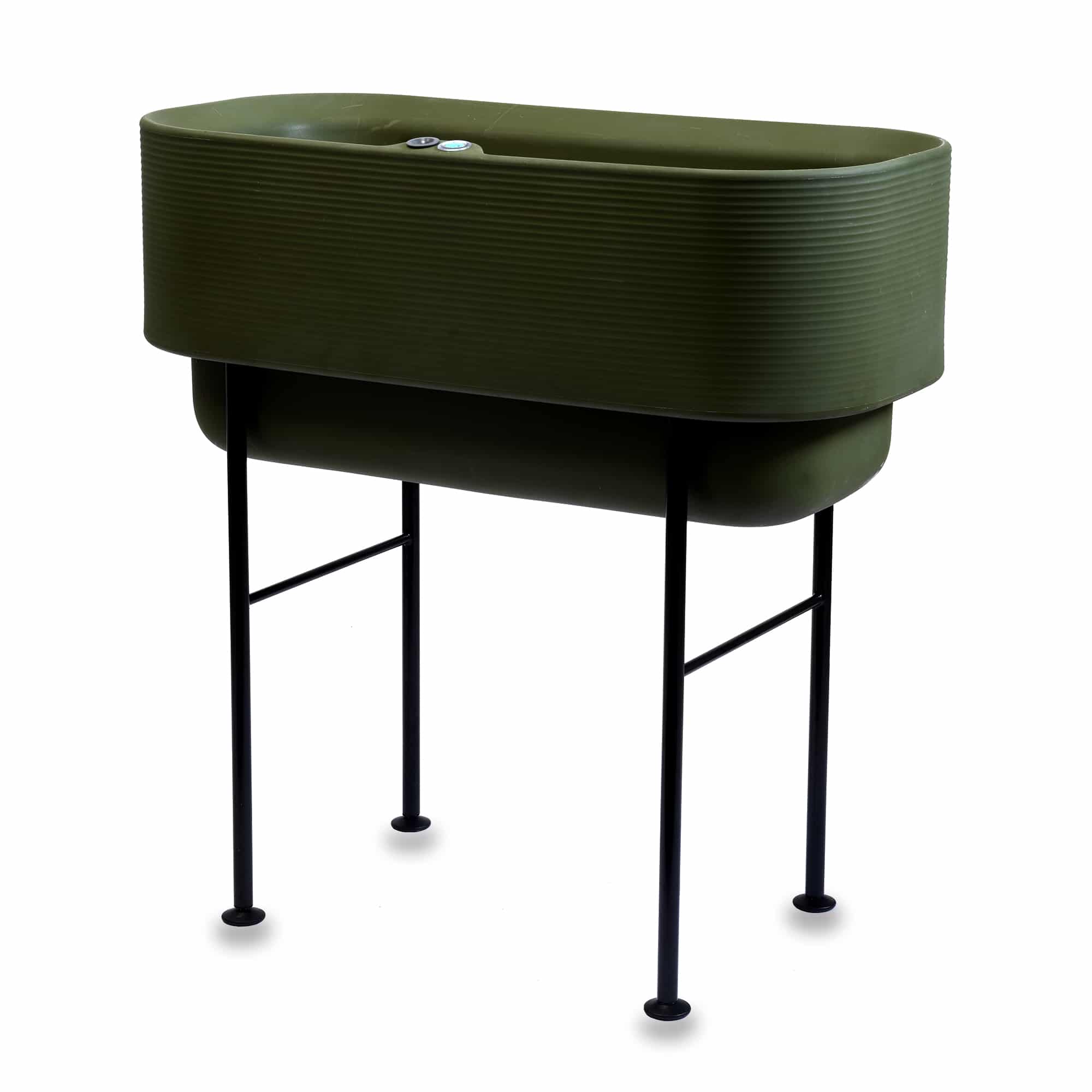The Ten Commandments of Container Gardening
Ok, boys and girls, it’s time to gather ‘round for a lesson on container gardening for beginners. Put on your best overalls and finest gardening gloves, pull up your wheelbarrow to the potting shed and sit back on your weeding stool as I present today’s sermon on the Ten Commandments of Container Gardening. These “commandments” are important gardening tips to help you be successful in your container gardening endeavors.
I. Success begins with what’s in your SOIL. Just like Grandma used to say: “It’s what’s on the inside that counts.” Having the right type of soil in your pots is a vital ingredient in your preparation to growing season long plantings, whether they are herbs, vegetables, flowers, or woody plants. You want what is often referred to as “soil-less soil”, a product that is a porous, well-draining mixture of compost, vermiculite, peat moss, water retention particles, and is free of soil-born diseases and weeds. Using garden soil or topsoil will cause the container mix to quickly become compacted, not giving tender roots an opportunity to grow. When you fill your planter with the potting soil, remember that it will compress a little over time and after it is initially watered. Ideally, you will want about an inch of space between the top of the potting soil and the rim of the planter so that when you water, the water stays in the planter and soaks down rather than run off over the outside of the pot.
II. Let the sun guide you in everything you do. Wherever you place your planters, be aware of how much sun (or how little sun) that planter will receive. Fill your pots only with plants that like the same sun requirements. For instance, Lantana is a full sun plant that needs at least 6 hours of sun to bloom well. Don’t mix Lantana with Torenia, a plant that fries in all day sun. Know the sun requirements of your plants, and don’t believe everything you read on the plant tag! Full sun in Michigan (where a lot of tags are made) is much different than full sun in Texas. When trying a new plant, talk to someone knowledgeable about the sun requirements for that plant. Your local garden center staff will be good resources to help you learn how much sun your plants need plus the care requirements for your plants.
III. Know your own gardening limitations and do not covet your neighbor’s abilities. Take an honest look at your time constraints or physical limitations and only plant what you can maintain. Choose low maintenance annual plants for your summer containers like mandevilla, allamanda, begonia, duranta, caladium, or Kimberly queen ferns if you know you have little time for deadheading and watering. If you know you aren’t the type to move your less cold-hardy concrete or clay pots inside for the winter, choose a durable plastic planter that you can leave outdoors for all seasons. Growing evergreen plants in your pots year-round is an easy way to keep your planters low maintenance. Even if your neighbor can grow a whole grocery store in his patio planters, don’t let that intimidate you out of the pleasure of growing a few herbs on your windowsill!
IV. Know your gardening style and plant accordingly. If you love a cottage garden container look, plant lots of annual, perennials and flowering shrubs. Look for loose airy plants like gaura, bidens, callibrachoa, gaillardia, scabiosa, or butterfly bush. If you enjoy a more formal look, use boxwoods, topiaries, compact shrubs like Gumpo Azaleas, annuals like Geraniums, or perennials with a uniform look like Veronica Sunny Border Blue or Dianthus Pixie. Choose a pot that reflects that style also. It is quite incongruous to see a log cabin style home with formal cast iron urns by the front door. Make sure the size of your planters corresponds with the space in which it is placed. Big spaces need big flower pots.
V. Remember when planting your pots to keep them holey. A planter without a hole is a water garden. Make sure you have good drainage in your pots. Most plants do not like to be waterlogged and tend to die more quickly from root rot than drying out. Folks have utilized just about anything as a planter to grow their flowers, fruits, herbs, and vegetables. But they all have needed to use a tool to drill a few holes in the bottom of their creative upcycled new garden pot to make it a good growing environment for the plants.
VI. Always protect the root ball of your plants when planting them in your pots. Removing a plant from its nursery pot is an important first step in starting your container garden with a healthy plant. Squeeze the nursery pot to loosen up the soil and roots within the nursery pot. Place one hand around the base of the plant, on top of the potted soil. With your other hand, tip over the pot so that the plant and soil slide out together. You might need to tap the pot again to loosen the soil from the edges. You generally don’t want to pull the plant out, especially from a larger pot, as it may rip out part of the root system. Use either your fingers or the blade of your trowel to relax the root ball before you put it into the planter to ensure that the roots start to reach out into the soil rather than keep wrapping around the root system. Plant the root ball so that the top of the plant’s root ball is level with the top of the potting soil. (It’s helpful to water your new plants before removing them from the nursery pot, but it’s very important to water the planter well immediately after you finish planting it. The dry potting soil will pull the moisture from your new plants’ root ball so make sure the new potting soil gets a good soaking.)
VII. Make sure you know what size your plant will grow to during the growing season. Instant gratification is a common theme in our society so folks often will plant way too many plants to fill up a container in the early spring, only to find that the only plant that they see in August is the one little sweet potato vine that overtook the other plants. Read carefully the height and width potential of your young plants so you don’t end up with a six-foot-tall ornamental grass in your 12” tall planter.
VIII. Don’t forget to fertilize! Annual plants are generally heavy feeders so use both a slow-release fertilizer when planting, then feed regularly throughout the season with a water-soluble fertilizer for flowering plants. Plants in containers usually require more watering than plants in the ground, which means that nutrients are being washed out. Learn what the fertilizing requirements are for the plants in your container and faithfully apply. In plants that are self-watering, a water-soluble fertilizer can be added to the water for a continuous feed.
IX. Check regularly for pest and disease. There are several good products for treating Aphids, pests, and fungal disease but the best treatment starts with getting healthy plants. Inspect your plants before purchasing and ask your local garden center what to look for with your particular plants.
X. Remember the words of Hortius Culturii, “A plant without fertilizer is weak. A plant without water is dead.” Don’t forget to water your plants. If you are new to gardening, invest in a self-watering planter with indicators that let you know when it’s time to water again. Or install irrigation tubing to your containers if you know you’ll be traveling or working long past watering hours. There are quite a few products that you can add into your potting soil or into the pots that help with watering. But most importantly, check the soil to see if it looks dry and the plant to see if it looks droopy.
While not quite “commandments”, here are a few other gardening tips. Consider adding a fine layer of sphagnum moss, pine fines, pine straw, pebbles or sand on the top of your planters’ potting soil to hold in moisture and give your planter a finished look, especially if you are planting smaller plants that will eventually fill up the planter. Next tip to consider, some pots are made with “feet” that allow them to be slightly elevated off the ground so that water can flow out. If your planters don’t have these feet you can find products that can do that for you that are often appropriately called “pot feet”. If you worried about water run-off or have indoor plants, use a clear or matching saucer under your planter or use a self-watering planter. Finally, place your planter where you want it before planting. Consider how you will water it and how close the access to water will be. For example, if you have pots at the end of your driveway, consider planting them with succulents or very drought tolerant plants since they may be the most difficult to get water to.
Hundreds of books have been written about all things gardening so we are hoping this quick summary of container gardening basics can be your quick reference tool as you go on your way to successful gardening.
